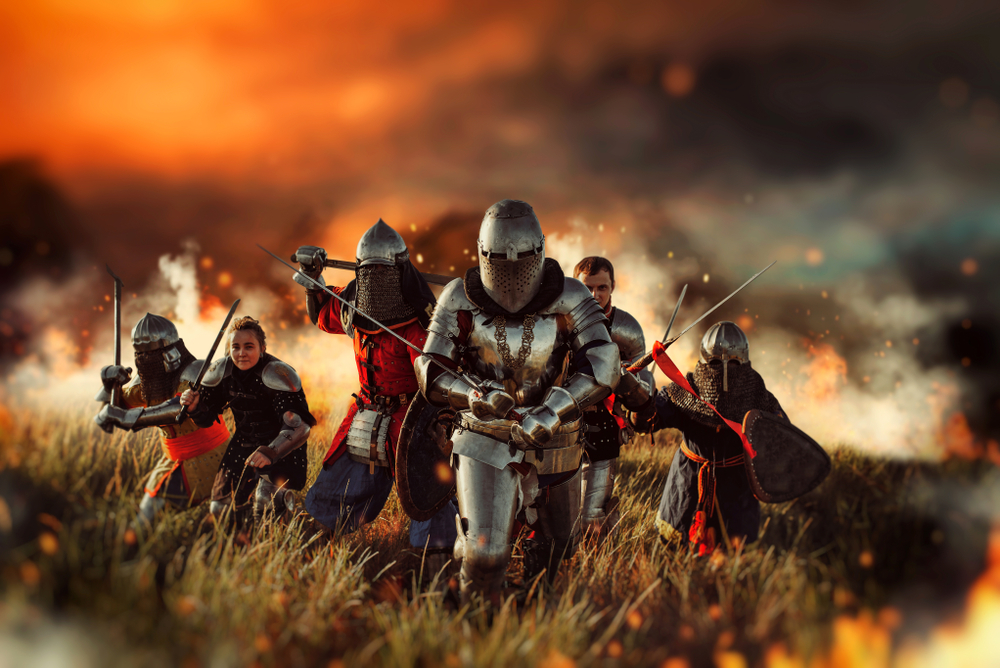
19 Apr The Barony of Flamstead – Part I
What more could you ask for than a Barony title in return for helping out at the Battle of Hastings? The Barony of Flamstead was exactly that. It was a reward given to Ralph de Tosny for accompanying William the Conqueror. He’d already enjoyed the hereditary office of Standard Bearer to Duke William, but he relinquished this in order to be able to fight closer to the duke. A bit overly keen to take part in battle, do you think? Perhaps. But it comes as no surprise when you also learn that the Tosny family could trace their roots back to the famous Viking, Rollo. 
By 1103, the second Baron of Flamstead, Ralph’s son – also called Ralph – had become one of the most powerful barons in England. And, as with many powerful baronial families of the time, the name fell in and out of favour with the monarch over several generations. Lands and reputation were lost and regained as rhythmically as the sea tides.
Richard the Lionheart
By 1189, the Barony of Flamstead was with its 5th title holder, Roger, who was a keen crusader. Whilst accompanying Richard the Lionheart on a crusade, Roger came upon an occasion where he wished to grant a gift to St Evroul. The fellow, however, was stuck without a seal, and King Richard kindly offered his own seal for use instead.
A bond was formed between the two men, and Roger distinguished himself at the battle of Arsuf by King Richard’s side. He also fought alongside Richard at Jaffa and helped him capture the Saracen envoy, El-Khuweilfe. However, in 1196, Roger found himself owing scutage (payment in lieu of providing fighting men) of 40 shillings for King Richard’s ransom. Within a year, he had also sworn on behalf of King Richard, to observe a treaty with the Count of Flanders.
King John
However, the year after that Richard died and Roger strategically switched to acting as surety on behalf of King John for the treaty with France. This deed earned him the return of Conches Castle, which he’d lost the previous year when it had been captured by the French.
Such was the strengthening of this new bond between Roger and King John, that by 1202, John had paid the outstanding scutage that had been due during King Richard’s reign. However, this relationship was not popular abroad, and Roger found himself stripped of his lordships on the continent due to his doting support. Sadly for Roger, he also died before King John had a chance to be cornered into signing Magna Carta, and it was at this point that the barony passed to his son, Ralph.
A rebelling 6th Baron
Ralph was seemingly not as reliable as his father. Initially in favour, King John granted him extensive lands in Essex, Buckinghamshire, Cambridgeshire, Norfolk, Suffolk, and Huntingdonshire. However, soon after the generous act, Ralph then joined the rebel barons and John ordered the Sheriff of Worcester to seize the lands.
However, John’s demise the same year, in 1216, put paid to any further disputes between the two men. And by 1233 King Henry III had granted custody of Maud Castle to Ralph. He was also appointed a General of the Poitevin mercenaries in the Welsh Marches and charged to fight against King Llewellyn. Clearly successful in some ways, by 1234 he found himself in command of keeping the peace with King Llewellyn and had been forbidden from attending tournaments at Northampton and Cambridge. Why? We will never know. But he wasn’t happy about it, and this Ralph then headed off on another crusade to meet his demise.
Some things change, some things don’t
A further series of Rogers and Ralphs carried the barony title to its 10th holder, who broke the mould by being called Alice. Having already been widowed, Alice married Guy de Beauchamp, the Earl of Warwick, in 1309; who then took on the title by dint of this marriage. Guy had an antagonistic relationship with the king, Edward II, which wasn’t unnormal for the times. However he also had a distinctive quality of foaming at the mouth when he was angry. As a result, King Edward had endowed him with the nick name, ‘Black Dog of Arden’, and the tension between the two men grew.
Within a year, Guy had been banned from entering parliament bearing arms. He had also become the leader of a group of earls and barons called ‘the Ordainers’. Their objective was to draft a set of ordinances that would restrict both the king’s finances and his right to appoint his own ministers. This wasn’t well received, as you’d expect. And to add salt to King Edward’s wound, Guy and the Earl of Lancaster then refused to join the king in his first major campaign against the Scots.
King Edward suffered a humiliating defeat at the Battle of Bannockburn in 1314. This weakened his position significantly enough to force him to confirm the ordinances and submit to the barons’ demands. Mysteriously, Guy fell ill at this point, and rumours abounded that he’d been poisoned by order of the king…
… Come back next month to find out what then happened to this fascinating title. The Barony of Flamstead still had a lot of history to work through before it fell into obscurity.
If you’d like to enquire about purchasing the Barony of Flamstead title, please click here.



